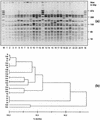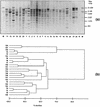Influence of transferable genetic determinants on the outcome of typing methods commonly used for Enterococcus faecium
- PMID: 12682136
- PMCID: PMC153884
- DOI: 10.1128/JCM.41.4.1499-1506.2003
Influence of transferable genetic determinants on the outcome of typing methods commonly used for Enterococcus faecium
Abstract
A variety of methods is used for a molecular typing of Enterococcus spp. and related gram-positive bacteria including macrorestriction analysis using pulsed-field gel electrophoresis (PFGE), ribotyping, rapid amplification of polymorphic DNA (RAPD), and amplified fragment length polymorphism (AFLP). To test the influence of transferable determinants on the outcome of different typing methods commonly used for enterococci, we established a homogenous strain collection of 24 transconjugants resulting from filter matings with antibiotic-resistant Enterococcus faecium. As expected, AFLP, RAPD, and PFGE all identified our model bacteria as strongly related. However, distinct differences in the resolving and discriminatory power of the tested methods could be clearly addressed. In PFGE, 22 of 24 transconjugants possessed less than a three-band difference to the recipient pattern and would be regarded as strongly related. Three different RAPD PCRs were tested; in two reactions, identical patterns for all transconjugants and the recipient were produced. One RAPD PCR produced an identical pattern for 18 transconjugants and the recipient and a clearly different pattern for the remaining 6 transconjugants due to a newly appearing fragment resulting from acquisition of the tetL gene. AFLP clusters all transconjugants into a group of major relatedness. Percent similarities were highly dependent on the method used for calculating the similarity coefficient (curve-based versus band-based similarity coefficient). Fragment patterns of digested plasmids showed the possession of nonidentical plasmids in most transconjugants. PFGE still could be recommended as the method of choice. Nevertheless, the more-modern AFLP approach produces patterns of comparable discriminatory power while possessing some advantages over PFGE (less-time-consuming internal standards). Plasmid fingerprints can be included to subdifferentiate enterococcal isolates possessing identical macrorestriction and PCR typing patterns.
Figures




References
-
- Aarestrup, F. M., Y. Agerso, P. Gerner-Smidt, M. Madsen, and L. B. Jensen. 2000. Comparison of antimicrobial resistance phenotypes and resistance genes in Enterococcus faecalis and Enterococcus faecium from humans in the community, broilers, and pigs in Denmark. Diagn. Microbiol. Infect. Dis. 37:127-137. - PubMed
-
- Antonishyn, N. A., R. R. McDonald, E. L. Chan, G. Horsman, C. E. Woodmansee, P. S. Falk, and C. G. Mayhall. 2000. Evaluation of fluorescence-based amplified fragment length polymorphism analysis for molecular typing in hospital epidemiology: comparison with pulsed-field gel electrophoresis for typing strains of vancomycin-resistant Enterococcus faecium. J. Clin. Microbiol. 38:4058-4065. - PMC - PubMed
-
- Barton, B. M., G. P. Harding, and A. Zuccharelli. 1995. A general method for detecting and sizing large plasmids. Anal. Biochem. 226:235-240. - PubMed
Publication types
MeSH terms
Substances
LinkOut - more resources
Full Text Sources
Research Materials
Miscellaneous

